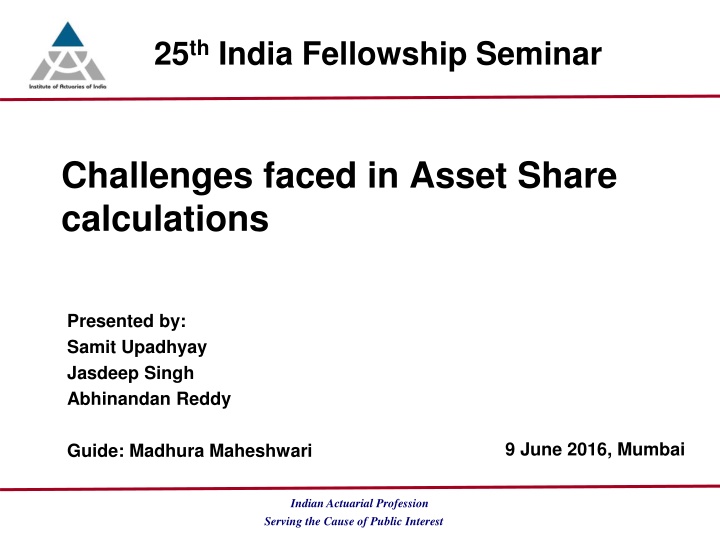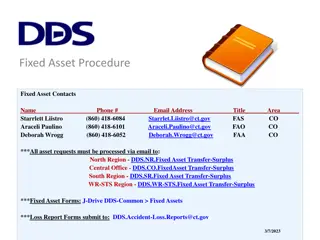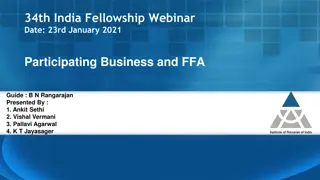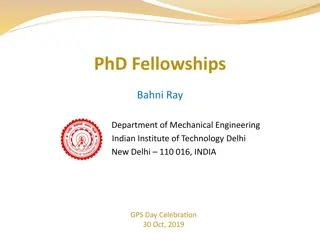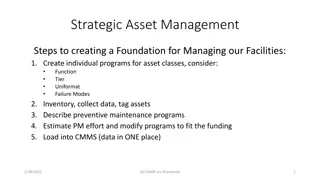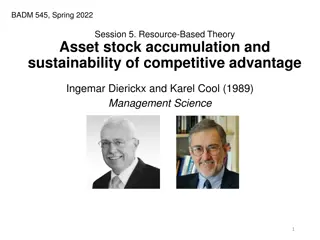Challenges in Asset Share Calculations: Insights from India Fellowship Seminar
In the 25th India Fellowship Seminar, Samit Upadhyay, Jasdeep Singh, and Abhinandan Reddy highlighted the challenges faced in asset share calculations. The presentation discussed the role of asset share, key considerations, principles from Guidance Note 6, calculation challenges, and possible alternatives, shedding light on the complexities involved in this process.
Download Presentation

Please find below an Image/Link to download the presentation.
The content on the website is provided AS IS for your information and personal use only. It may not be sold, licensed, or shared on other websites without obtaining consent from the author.If you encounter any issues during the download, it is possible that the publisher has removed the file from their server.
You are allowed to download the files provided on this website for personal or commercial use, subject to the condition that they are used lawfully. All files are the property of their respective owners.
The content on the website is provided AS IS for your information and personal use only. It may not be sold, licensed, or shared on other websites without obtaining consent from the author.
E N D
Presentation Transcript
25th India Fellowship Seminar Challenges faced in Asset Share calculations Presented by: Samit Upadhyay Jasdeep Singh Abhinandan Reddy 9 June 2016, Mumbai Guide: Madhura Maheshwari Indian Actuarial Profession Serving the Cause of Public Interest
Agenda Introduction Define Asset Share Role of Asset Share Key Consideration in Asset Share Calculation Principles From Guidance Note 6 Challenges in calculation Possible Alternatives Questions www.actuariesindia.org 2
Introduction www.actuariesindia.org 3
Introduction Asset Share is Premiums Benefit Outgo Accumulation of - Investment Returns Expenses Commission Taxes Shareholder Transfers Cost of Guarantee & Capital Charges Miscellaneous Surplus GN6 definition - An asset share for a policy grouping at a given point in time is the accumulation of the premiums received plus investment income earned from the inception of the policies, less deductions due to benefit payments, commission, expenses, tax, a reasonable cost of capital and of guarantees, contribution from miscellaneous surplus (if considered appropriate) and transfers to shareholders. www.actuariesindia.org 4
Introduction Surrender Value Calculation Maturity Value Calculation Declaration of Bonuses Death Value Calculation Role of Asset Share Cost of Guarantee Calculations Investment Strategy Reserving Survey Result - Role of Asset Shares among Indian Companies Milliman India Asset Share Survey 04th February 2014 www.actuariesindia.org 5
Key Considerations www.actuariesindia.org 6
Key Considerations Policy Grouping Data Basis Smoothing Others www.actuariesindia.org 7
Key Considerations Policy Grouping Data Basis Smoothing Others www.actuariesindia.org 8
Policy Grouping Principles As per GN6 The Appointed Actuary should consider whether it is appropriate to group policies for the purpose of determining bonus rates. Asset Share where calculated, should be determined for each policy grouping Basis for Setting up Groups Key Considerations for Setting Groups 1. Based on Key Product Features, such as - Similar Bonus Structure 1. Maintaining Equity The Grouping of policies should not materially disadvantage one group at the cost of other. - Type of Plan - Date of issue 2. Guided by Risk Sharing Rules Such as views on - Policyholder s age 2. Other Features, such as - Policy holder s Reasonable Expectation - Bonus earning capacity - Balance Between Risk & Reward - Moneyness of Guarantee www.actuariesindia.org 9
Policy Grouping Challenges Key Challenges in determining level of grouping for asset share calculation Determination of homogeneity Avoidance of cross subsidy especially if its systematic Too large Vs too small groups Large Group : High extent of cross subsidy Small Group : Credibility of basis and absence of sufficient pooling Ability to measure / estimate parameters at the group level. Investment : Hypothecation of assets and measurement of performance Mortality : Experience with sufficient credibility Others Establish equity, given practical constraints of systems www.actuariesindia.org 10
Policy Grouping Alternatives Possible Solution to address the challenges in grouping Minimise cross subsidy at pricing stage By considering volume Discounts Limit options under a bonus series Grouping Asset Share at appropriate level Start with broader groups and keep splitting as gain credibility Consider policyholder s reasonable expectation Consider the ability of declaration of different regular / terminal bonus rates Policy Level Asset Share & different groups for different parameters Example - Expenses based on year of issue and product , Investment based on SP/RP, moneyness of guarantees Aggregate policy level asset shares in groups of regular / terminal bonus series www.actuariesindia.org 11
Key Considerations Policy Grouping Data Basis Smoothing Others www.actuariesindia.org 12
Data : Challenges As per GN6 Wherever possible, the Appointed Actuary should make use of actual historical data ... to derive the historical asset share. Availability of complete and valid data Of contracts for policy level asset share calculation For measurement of experience Availability of granular data for historical operating experience - most significant challenges faced by companies* Especially an issue for companies moving to late adoption of asset share Exacerbated if historical data not stored / captured / complete Further, difficult to validate * Millman - India Asset Share Survey 2014 www.actuariesindia.org 13
Data : Challenges Availability of granular data for historical operating experience - most significant challenges faced by companies* * Millman - India Asset Share Survey 2014 www.actuariesindia.org 14
Data : Possible Solutions Invest in resources to collate & validate data Consistent with Statutory Valuation As per GN 6 use of proxies to the actual historical experience Only when detailed historical data not available Validate the parameters used Alternate systems like accounting etc. Checking split between asset share and estate by sources of surplus method www.actuariesindia.org 15
Key Considerations Policy Grouping Data Basis Smoothing Others www.actuariesindia.org 16
Basis Principles Identification & Documentation Treatment (for both surplus & deficit) of various sources of surplus Guides : Past practice / Benefit Illustration / PRE Equity, fairness & consistency of approach from year on year Once sources to be shared ascertained Use historical experience, only if not available, proxy best estimates can be used Correspondence between benefit and charge Consistency depending on the use of asset shares Statutory valuation basis and book value asset shares Bonus declaration and possibly market value asset shares www.actuariesindia.org 17
Basis Challenges(1) In general for various parameters need to establish if asset shares would be allocated Charges : No sharing of surplus Experience : Sharing of surplus Identification of sources : Requires complex modelling, granular experience and attribution analysis Distribution of a source : usually requires some evidence of recurrence Companies are in various stages of operation and emergence of surplus is not uniform in each stage Initial phase : expense overrun Growth phase : high lapse profits Maturity phase : relatively low surrender profits www.actuariesindia.org 18
Basis Challenges(2) Conflicting choices for attribution of a source Competitiveness of existing business vs Support New Business overruns Solvency of the fund vs boost to payout values Fairness vs Smoothing and implications to PRE Equitable allocation of lapse / surrender surplus to continuing policies May not be fair to share deficit automatically if surplus was shared, eg. Mortality deficit due to increase in Non Medical Limits for new business Suitability of expression of a charge wrt a dependent variable, eg. Moneyness and Cost of Guarantee may not correspond to Charge for Guarantee (% of asset shares) Allocation of global items like burn through cost Deferred Tax Asset www.actuariesindia.org 19
Basis Alternatives (1) Attribution of Charge vs Experience Consistency with Benefit Illustration is paramount (not only figures but also foot-notes) Adequate documentation (possibly in PPFM) of rationale with expected future treatment shall ensure continuity Decision making could be shared with the WPC - to ensure consideration from a wider perspective Test recurrence / emergence of surplus in various plausible scenarios Decision could be made given FCR scenarios ( possibly even longer term, if appropriate) Depending on lifestage of the Company, form risk sharing groups, eg Only policies that supported acquisition overruns shall be shielded from renewal expense overrun or will not be charged cost of capital etc. www.actuariesindia.org 20
Basis Alternatives (2) Target minimising inter generational cross subsidy Measure and attribute parameters at appropriate risk group level Test suitability of charge and its expression by dynamic projection of Asset Shares Allocation of investment returns commensurate with CoG Allocation of global Items like burn through cost and DTA could be on Marginal basis : allocate marginal cost to incremental business Contribution basis : Each policy contributes to its share of tax and a higher CoG contribution www.actuariesindia.org 21
Key Considerations Policy Grouping Data Basis Smoothing Others www.actuariesindia.org 22
Smoothing : Principle Essential characteristic of with profits business May pool business both within a generation and between generations Presence of some discretion, however the AA should consider following Genuine reduction in volatility of payouts Change in risks of statutory / realistic solvency All policyholders treated fairly Consider treatment of smoothing surplus / deficit and if it is Shared with survivors Credited to estate / asset shares Is consistent with PRE www.actuariesindia.org 23
Smoothing : Challenges Explicit identification of smoothing account Should be supported by asset share or estate Appropriateness of various smoothing methods Balance between extent of smoothing and deemed satisfaction of PRE Choice between smoothing input parameters like investment return or pay out values Joint impact of smoothing rules with dynamic management actions Impact on charge for guarantee Requires complex modelling www.actuariesindia.org 24
Smoothing : Possible Solutions May be simpler to input unsmoothed parameters and smooth payouts Test resilience of smoothing rules with management actions using stochastic methods Test if the account tends to zero over medium term Document the approach - after testing run off of entire business in various economic / operating scenarios Minimise reliance on estate for smoothing by Maintain smoothing reserve account as a component of reserve for future bonus to avoid reserving over and above asset share Smooth both regular bonuses as well as terminal bonus to keep smoothing reserve to its minimum as well as meet PRE www.actuariesindia.org 25
Key Considerations Policy Grouping Data Basis Smoothing Others www.actuariesindia.org 26
Others Principle Miscellaneous attribution Pricing of rider / non par elements needs to be fair Reinsurance arrangement should consider risk vs reward, especially if non par business is written in the fund and surplus shared Overall should be as per PRE of par policyholders Segregation and merger considerations Formal / notional segregation of funds and respective asset shares Could also be merged if benefits expected from diversification Separation of measurement / allocation of parameters Appropriate disclosure made to existing and prospective policyholders www.actuariesindia.org 27
Other Challenges Allocation of miscellaneous surplus due to absence of separate bonus series could lead to inequity if material between reinsured and not reinsured policies between with rider and without rider policies Allocating the effects of reinsurance especially in surplus/ non proportional type of reinsurance In case of non par business / riders a balance between solvency of the par fund and fairness of pricing Ability to administer multiple systems in case of a merger Can significantly increase complexity around data and measurement of parameters Trade off between diversification credit and separation of allocation to asset shares www.actuariesindia.org 28
Others Alternatives Reinsurance The effect of reinsurance can be clubbed with mortality experience / charge This could include the allocated premium for cat re or any other non proportional arrangement Rider/ Non par business Could shield the par policyholders till parameter estimates gain credibility Experience sharing reinsurance arrangements can be helpful to balance solvency and fairness Segregation / Merger AA should document the structure and rationale of the sub-funds and the risks that are shared within each sub-fund for experience pooling Consistent treatment from year on year www.actuariesindia.org 29
Thank You Questions? www.actuariesindia.org 30
